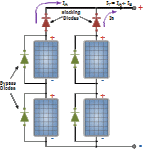Here's the guts of the panel. I fired it up in my living room, and everything works as expected. Can't test the BCDC and magnum until I put it in the vehicle.
Not as pretty as the front no doubt, but gets the job done.
Red SB175 Anderson plug = alternator hookup to BCDC
Yellow SB175 Anderson = solar hookup to BCDC
Primary fuses at the left is a Blue sea MBRF fuse block for the loads, BCDC, and Magnum.
3 shunts at the upper right
2 negative load busses at the bottom
Anderson plugs on the right:
Gray SB50 = Air compressors
Green SB50 = audio amplifier
white/yellow/orange/red/black APPs at the top = hookup to steering column fuse panel
white = ignition tap (currently not used, can't find an ignition tap)
orange = constant starter 12v, used to power the Blue sea 1830 battery monitor and read voltage
red/black = power to fuse panel under steering column
8 colored Anderson plugs at bottom = switch inputs for relays
8 colored anderson plugs in the middle + 2 black plugs = load power out to devices driven by relays, plus two ground wires. I've used a trailer cable (6x 12 AWG, 1x 10 AWG) as a power cable to the hood, terminated by a terminal block where accessories can hook up to, and a common bus bar using the single 10 AWG wire. This way no relays are exposed to the elements
That's pretty much it!






